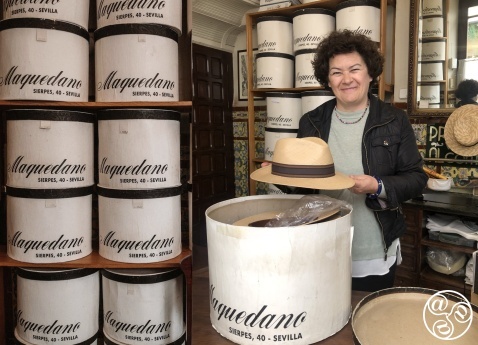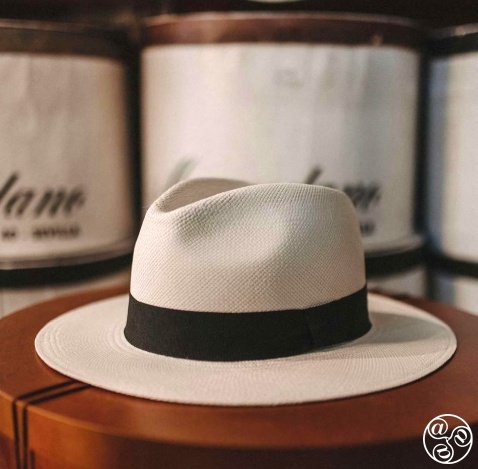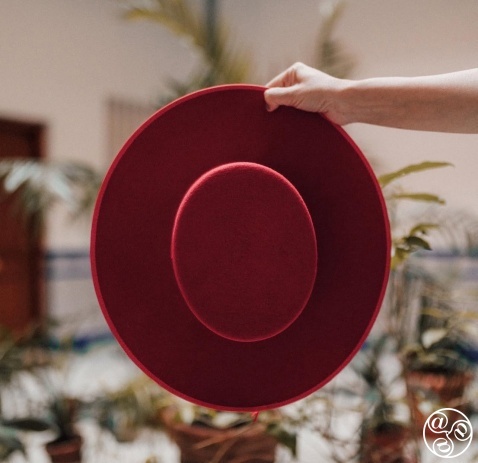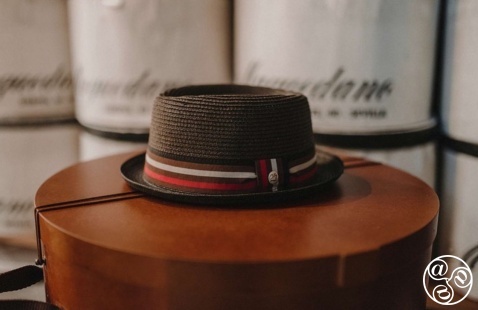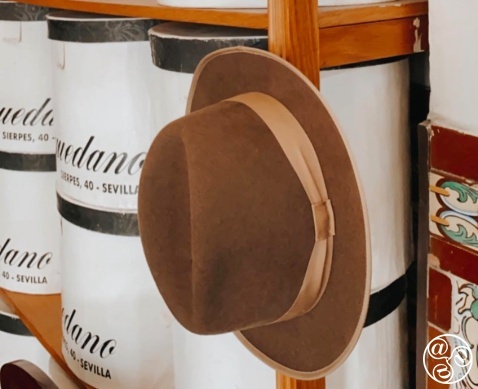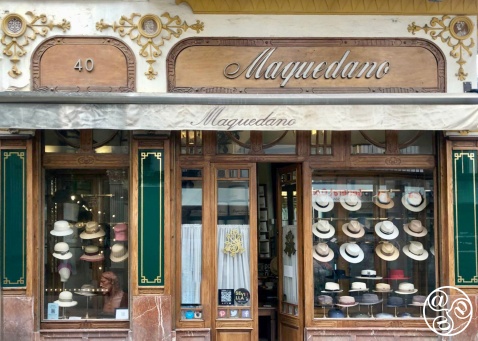
Marble and carved wood frame the historic facade of Maquedano Hat Shop in Seville © Fiona Flores |
|
Sombrerería Maquedano Hat Shop
Interview with Cristina Vega of Sombrerería Maquedano in Seville
by Fiona Flores Watson
We talked to Cristina Vega, manager of Seville’s first, and oldest, hat shop, which has been family-run since 1896, in its current site on Calle Sierpes since 1908. When a sevillano needs headgear for the Feria, a wedding, a beach trip, or to match their winter coat, Sombrerería Maquedano is where generations have headed. The shop still conserves its original décor, complete with wooden façade, pretty coloured tiles, and a spiral staircase with metal banister, while towers of circular hat boxes bearing the striking logo reach up to the ceiling. A simple table in front of the door, with a small mirror for customers to check their potential purchase, serves as the shop counter.
Note: in Spanish, a sombrero is defined as a wide-brimmed hat that is not tightly fitted to the wearer’s head, while a gorro is more close-fitting.
Andalucia.com: Why is your shop called Sombrerería Maquedano?
Cristina Vega: The shop was founded by Federico Cardenas and his brother-in-law Juan Maquedano in 1896. First it was located in calle Almirante Apodaca, then in 1908 it moved here, to calle Sierpes. Federico Cardenas was my great-grandmother’s godfather. Both men died old without children, and the shop passed to my great-grandparents, who worked here their entire lives, until their 90s. Then it passed to my mother [Cristina Menendez]. She is still the boss, but she retired a few years ago. And now I’m here. I’ve been here for 22 or 23 years. Ideally I would like someone from the family to keep the shop on. I don’t have children, and my niece is only seven years old.
AC: Tell us how you came to be working at the shop?
CV: I studied French at university, but I didn’t like teaching – I didn’t want to be a teacher, or a translator or interpreter. I started working at the shop, part-time, while our assistant Miguel was still here, before he retired, and my mother was still here too. Then when he retired, I decide to work here full time.
The shop is like my right hand, it forms part of me. But as the years go by, I don’t want to spend the rest of my life working here.
AC: What sorts/styles of hats do you sell?
CV: The most popular hats are Panama. They are summer hats, but people also buy them at Christmas as presents.
We have many styles of Panama, Feria hats such as sevillano and cañero for men, and catite and calañes [small velvet hats] for ladies and men; trilbies, flat caps, cloche hats, and sunhats.
We also have porkpie hats, with a very narrow brim, which are associated with jazz. Usually men buy these hats, but women do as well. Flat caps (gorras) are very popular in winter.
In summer, people who are visiting Seville come in to buy a sombrero to protect them from the sun. They don’t realise how strong the sun is.
Where are the hats that you sell made, and what are the different types of materials/fabrics are used to make a hat?
CV: Panamas are made using straw from Ecuador. The straw is woven there, and then sent to Spain or Belgium, where it is shaped into a hat. There are two towns in Alicante which make all types of hats, and also a factory in Almagro in Ciudad Real. Winter hats are made in Italy.
Panamas cost around 73-140 euros – the price depends on the fineness of the weave, especially around the brim. Cheaper versions are made using paper, which cost 30-40 euros.
The two materials used to make the cordobés type of wide-brimmed hat that you see at ferias are wool felt, and rabbit fur felt. [Felt is defined as a non-woven textile made by matting wool and other textiles together.] The rabbit pelt is better quality, you can see the difference – it is softer than the wool, and also more durable – it will last longer.
AC: Tell us about hats that we see people wearing at the Feria de Abril in Seville.
CV: Wide-brimmed hats, with a flat crown. The cordobés is one style, with a wide brim, and also the sevillano and the cañero. The most classic colours are black and grey; there is also a light brown, but the most used is grey. The sevillano has a narrower brim and a lower crown, while the cañero is a slightly wider brim and higher crown. The cordobés also has a high crown, which is more conical in shape. The one that is most widely worn in Seville is the cañero.
Of the velvet hats worn at the Feria, the calañes is the small one, without a brim. The catite has a wider brim. Both are made of velvet. The calañes sits on top of hair, and is only available in three sizes: child, woman, and man. An elastic strap at the back secures the hat, and it is often worn with a scarf bandana-style. I have loyal customers who always buy these hats here. I have them in black - before I had them in burgundy as well, but I changed supplier.
There are families of whom all the members buy their hats for the Feria here.
It depends on the hat's material is as to how long it will last – rabbit is more durable than wool felt – about 15 to 20 years, as opposed to 10 years.
AC;: How seasonal are hat sales?
I put the Panamas in the shop window in March. Well, this year the weather has been terrible, but normally I’m already selling them in March. So our summer display starts now, and lasts until October. Then we change to winter hats.
AC: How do you clean a hat? Do you offer this service to customers?
First you need to brush off the dust. Then you clean it using a brush, with warm water and ammonia.
We have a cleaning service here. Miguel, who worked in the shop for 50 years, is retired now, and he cleans the hats at home. He’s 87. People bring their hats to him before the Feria, he cleans them, and then they bring them again after El Rocio, and afterwards the hats are stored until next year.
AC: Do more tourists or sevillanos come here? How do their tastes differ?
CV: Both men and women buy Panamas. About half sevillanos and half from elsewhere – I have customers who have been buying their hats here since they were children.
Some customers who come in already wear hats, while others have been told by the doctor to wear a hat, and they don’t look at all happy about it. But then many of them end up being regular customers.
AC: Do the hats come in different sizes?
CV: Yes. Most people don’t know their own size; they have no idea. I can tell by looking at someone’s head - I don’t need to measure. I give them the right size, and they buy the hat. Some hats come in small, medium or large, while others are numbered, from 55 to 61 or 62. Women’s hats are one size only.
AC: Do you give advice to customers about which hat to buy?
CV: Sometimes customers ask me for a hat that they’ve seen in the shop window, and I offer them a different model which I think will suit them better; or they’re not sure what they want, so I suggest something. Often they end up buying the hat that I`ve suggested. Not always, but many times. I look at them, and see what would suit them.
The hat depends on the person’s character. I look at the shape of their face and their height. For women normally wide-brimmed hats at the best, especially with curly hair. For someone with short hair, a smaller hat. If a man has a thin face, then a narrow brim; with a wide face, then a broader brim.
AC: Tell us about the hat boxes that are piled up around the shop.
CV: Each box contains a different style - they’re not just for decoration! Many of the boxes have Panama hats inside them.
Miguel used to make the hat boxes for us, but he stopped around 5 or 6 years ago. We haven’t found anyone else to make them. I’ve asked around, because many of them are in a poor state, and I need new ones, but I can’t find anyone.
The boxes are made of cardboard, and then covered in paper. Some are stronger as they’ve been covered so many times. It’s the same design as when the shop first opened. Sometimes people ask for a box with their hat - both locals and tourists. But I only have these ones – I never sell them to anyone.
The two upstairs floors are also full of hat boxes. There are many models of Panama and also of winter hats and caps. I also have a storeroom in Calle Francos.
AC: Do you have any famous clients that you can tell us about?
CV: Famous clients who have bought hats in the shop include Baroness Thyssen (Tita Cervera) and Arturo Perez Reverte, who have both bought Panama hats here. Jesus Quintero would buy hats from here and then style them his own way, with a quirky hatband. Fran Rivero is another client.
AC: Tell us about your street in Seville, Sierpes.
CV: The street has changed a lot in recent years, as has Seville. I miss the traditional shops, like Idigoras, a classic men’s outfitter which used to be opposite. Also there was an umbrella shop, Casa Rubio, further down on this side of the street – the lady who owned it died, and the children didn’t want to keep it on, as often happens with long-established businesses.
I think it’s sad that we are losing the old, specialised shops with character these days. There are too many souvenir shops – it’s got out of control.
Whenever I am away, if I see an old shop, I always go straight in and talk to the people there. It draws me like a magnet, especially if it’s a hat shop!
AC: What is your favourite shop in Seville?
CV: Papeleria Ferrer [a traditional, family-owned stationery shop on the same street]. I am the happiest person in the world in a stationer’s or bookshop. I love notebooks for planning a trip. I love the smell of paper. I always go to Casa del Libro [nearby bookshop] to buy my books. I read in French and Spanish – years ago I used to read in English too. I like thriller writers like Miguel Santiago, Maria Oruña, Nagore Suárez, and Julia Navarro. I’m reading the latest Maria Dueñas; I’m really enjoying it.
AC: What is, for you, the best time of the year in Seville?
I don’t like the typical festivals, with all the noise and people, as I prefer quiet and calm. In August, the city is quieter.
AC: What is your favourite bar in Seville?
I live nearby, between the Alameda and Las Setas, so I can walk to work. I go out around calle Feria and the Alameda. I like Tarambana, and Al Aljibe’s provolone and rocket risotto is spectacular. It’s the only one I’ve found without mushrooms, which I don’t like. Also Maestro Rufino.
AC: Do you have a favourite Andalusian ingredient or special dish?
Croquettes are my favourite food – I’ve even found mushroom croquettes that I like! I like the typical ones, like ham, not fish or garlic prawns.
AC: What is your favourite place in Andalucia other than Seville?
I’ve just been to Écija – I really liked the city, aesthetically. It wasn’t too noisy, and there was a good amount of people there in the bars, and in the main square. It wasn’t deserted, but there were enough people – and just a few tourists.
AC: Tell us in one word what Andalucia means to you.
The word that sums up Andalucia for me is luz (light) – not just sunshine, but the quality of the light. On a cloudy day like today, the light is different.
